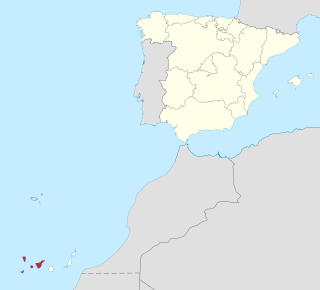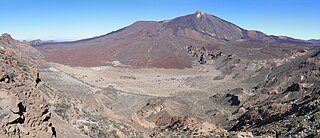
The Canary Islands, also known informally as the Canaries, are a Spanish autonomous community and archipelago in Macaronesia in the Atlantic Ocean. At their closest point to the African mainland, they are 100 kilometres west of Morocco and the Western Sahara. They are the southernmost of the autonomous communities of Spain. The islands have a population of 2.2 million people and are the most populous special territory of the European Union.

Province of Santa Cruz de Tenerife, also Province of Santa Cruz, is a province of Spain, consisting of the western part of the autonomous community of the Canary Islands. It consists of about half of the Atlantic archipelago: the islands of Tenerife, La Gomera, El Hierro, and La Palma. It occupies an area of 3,381 km2 (1,305 sq mi). It also includes a series of adjacent roques.

Tenerife is the largest and most populous island of the Canary Islands. It is home to 42.9% of the total population of the archipelago. With a land area of 2,034.38 square kilometres (785.48 sq mi) and a population of 948,815 inhabitants as of January 2023, it is also the most populous island of Spain and of Macaronesia.

Teide, or Mount Teide, is a volcano on Tenerife in the Canary Islands, Spain. Its summit is the highest point in Spain and the highest point above sea level in the islands of the Atlantic. If measured from the ocean floor, its height of 7,500 m (24,600 ft) makes Teide the third-highest volcano in the world, and is described by UNESCO and NASA as Earth's third-tallest volcanic structure. Teide's elevation above sea level makes Tenerife the tenth highest island in the world.

La Orotava is a town and a municipality in the northern part of Tenerife, one of the Canary Islands of Spain. The area of the municipality stretches from the north coast to the mountainous interior, and includes the summit of the Teide volcano, Canary Islands' and Spain's highest point at 3,718 m. At 207.31 km2, it is the largest municipality of the island of Tenerife. The population is 41,255 (2013).

Teide National Park is a national park located in Tenerife, Canary Islands, Spain.

The TF-1 is a motorway encircling the eastern and the southern parts of the island of Tenerife. The TF-1 motorway runs from the capital Santa Cruz in the north to Adeje with its major tourist resorts Los Cristianos and Playa de las Américas in the south of the island, and continues to Santiago del Teide in the west. It is a 103 km motorway and interchange numbers go facing south. The motorway is one in the Canary Islands that passes through most of the municipalities and is the longest in the archipelago as well.
The Great Fire of Valparaíso started on 12 April 2014 at 16:40 local time, in the hills of the city of Valparaíso, Chile. The wildfire destroyed at least 2,500 homes, leaving 11,000 people homeless. An additional 6,000 people were evacuated from the city, which was placed on red alert and declared a disaster zone. Fifteen people were confirmed killed and ten suffered serious injuries.
The Teide Trophy is a pre-season football tournament organised in Tenerife (Canary Islands. The matches are played at Estadio de Los Cuartos, a historic stadium located in La Orotava, a city in the north of the island.

A guachinche is a typical Canary Island establishment, more widely spread on the island of Tenerife and to a lesser extent in Gran Canaria, where a locally produced wine is served accompanied by homemade traditional food.

Fires in Galicia are caused by deforestation and brush clearing, the removal of indigenous fauna, and arsonists. The fires have been occurring since the mid-1990s. Fires in Galicia represent 50% of the area burned each year in Spain and 40% of all fires.

During August 2019, a number of forest fires broke out in the Canary Islands of Gran Canaria, Tenerife and Lanzarote. The fires on the island of Gran Canaria were the most severe, resulting in the loss of large areas of the island's forests and leading to the evacuation of thousands of residents from a number of towns and villages. The intense heat brought by a heat wave and the presence of strong winds, combined with the island's mountainous terrain, made extinguishing activities exceptionally difficult.

The 2020 Delta del Paraná wildfires is a series of wildfires that are burning across the Delta del Paraná in Argentina, affecting mainly the Entre Ríos and Santa Fe provinces, but also Buenos Aires, including major cities as Rosario.

The 2020 Córdoba wildfires are a series of wildfires burning through the Córdoba Province in Argentina.
The 2022 Tierra del Fuego wildfire is a fire affecting the Chilean commune of Timaukel in the west of Tierra del Fuego Island in southernmost South America. The fire was discovered on January 20 but since no flames could be found it was reportedly believed that it was already extinguished. It began in land owned by the forestry company Forestal Russfin. Days later the fire was envigorated and consumed various hectares of forest.

The 2022 Corrientes wildfires were a series of wildfires burning throughout the Corrientes Province in Argentina. It began in January of that year and continued to be active in many parts of the province, having consumed more than 800,000 hectares, which is equivalent to approximately ten percent of the province. The fire advanced over fields, mountains, wetlands and nature reserves, including the Iberá Wetlands, and has caused material damage estimated at between 25 and 40 billion pesos.

In mid-January 2022, the Southern Cone had a severe heat wave, which made the region for a while the hottest place on earth, with temperatures exceeding those of the Middle East. This extreme weather event was associated with the Atlantic anticyclone, a particularly intense La Niña phenomenon in the Pacific Ocean, and the regional effects of climate change.

Starting on 30 January 2023, a series of wildfires began in the South American country of Chile. By early February, the fires had developed into a large outbreak of at least 406 individual fires, several dozen of which were classified as "red alert fires". The fires burned more than 430,000 hectares and resulted in the loss of 24 lives, prompting the government to declare a state of emergency in multiple regions of the country.

In February 2024, a series of wildfires broke out in Chile, affecting multiple regions including Valparaíso, O'Higgins, Maule, Biobío, and Los Lagos. The most severe incidents occurred in the Valparaíso Region as of 5 February 2024. The Chilean government labeled the fires as the country's worst disaster since the 2010 Chile earthquake, and declared a two-day national mourning period.

















